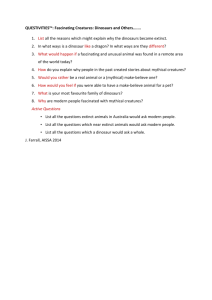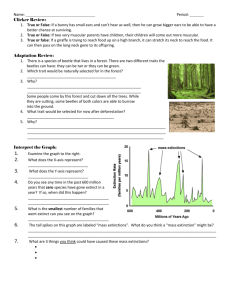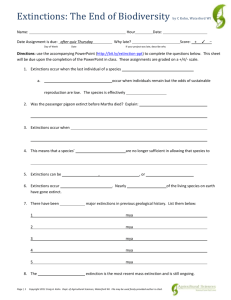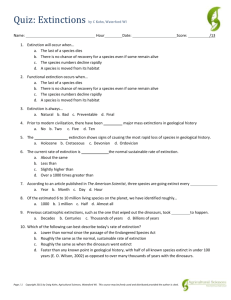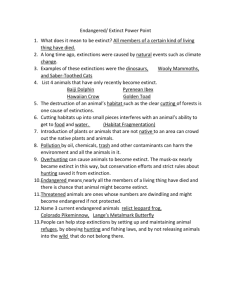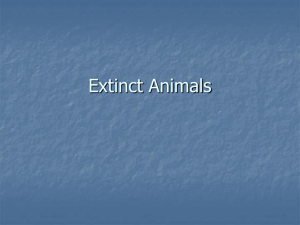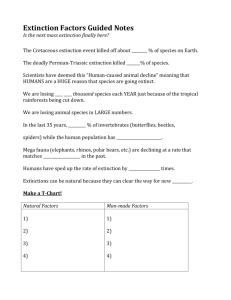Science Book report - SMS-HB09
advertisement
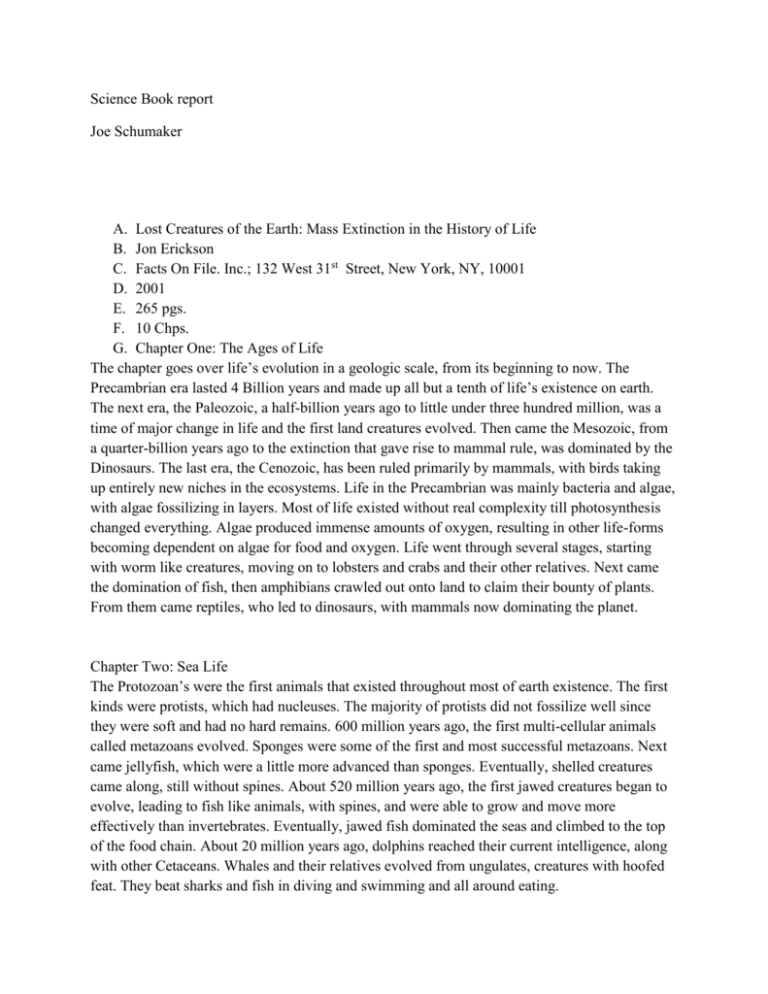
Science Book report Joe Schumaker A. Lost Creatures of the Earth: Mass Extinction in the History of Life B. Jon Erickson C. Facts On File. Inc.; 132 West 31st Street, New York, NY, 10001 D. 2001 E. 265 pgs. F. 10 Chps. G. Chapter One: The Ages of Life The chapter goes over life’s evolution in a geologic scale, from its beginning to now. The Precambrian era lasted 4 Billion years and made up all but a tenth of life’s existence on earth. The next era, the Paleozoic, a half-billion years ago to little under three hundred million, was a time of major change in life and the first land creatures evolved. Then came the Mesozoic, from a quarter-billion years ago to the extinction that gave rise to mammal rule, was dominated by the Dinosaurs. The last era, the Cenozoic, has been ruled primarily by mammals, with birds taking up entirely new niches in the ecosystems. Life in the Precambrian was mainly bacteria and algae, with algae fossilizing in layers. Most of life existed without real complexity till photosynthesis changed everything. Algae produced immense amounts of oxygen, resulting in other life-forms becoming dependent on algae for food and oxygen. Life went through several stages, starting with worm like creatures, moving on to lobsters and crabs and their other relatives. Next came the domination of fish, then amphibians crawled out onto land to claim their bounty of plants. From them came reptiles, who led to dinosaurs, with mammals now dominating the planet. Chapter Two: Sea Life The Protozoan’s were the first animals that existed throughout most of earth existence. The first kinds were protists, which had nucleuses. The majority of protists did not fossilize well since they were soft and had no hard remains. 600 million years ago, the first multi-cellular animals called metazoans evolved. Sponges were some of the first and most successful metazoans. Next came jellyfish, which were a little more advanced than sponges. Eventually, shelled creatures came along, still without spines. About 520 million years ago, the first jawed creatures began to evolve, leading to fish like animals, with spines, and were able to grow and move more effectively than invertebrates. Eventually, jawed fish dominated the seas and climbed to the top of the food chain. About 20 million years ago, dolphins reached their current intelligence, along with other Cetaceans. Whales and their relatives evolved from ungulates, creatures with hoofed feat. They beat sharks and fish in diving and swimming and all around eating. Chapter Three: Land life The first life to venture out of the seas was plants, only needing light and water to survive. The first of those were mosses and lichens. They eventually gave rise to gymnosperms, which resulted in club mosses, and most of today’s modern plants. Plants called lycopods were the dominant type in ancient swamps, with their branches growing a spiral. Many plants in the swamps remained unbeaten when they died and formed massive amounts of coal after fossilization. True ferns became widespread through the Mesozoic and became a staple food for dinosaurs. Eventually, amphibians crawled upon the land and began a rapid expansion. Reptiles first evolved just 300 million years ago to dominate the land. They even spread into the sea and air. With narrower tracks and longer steps, they could easily run down their prey. Their scales allowed them to keep their fluids in and meant the animal only needed to drink water and not live in it. Eventually, mammal like reptiles evolved and showed improvements over their predecessors. With better body temperature control and fur, they were able to keep more of their energy, lessening the food needed for their active lifestyles. The dinosaurs took over before mammals could fully evolve, and they reigned over the earth for millions of years, producing a wide variety of creatures of all shapes and sizes. Small dinosaurs eventually evolved into primitive birds, and took to the skies. After the extinction of dinosaurs, mammals grew in size and rapidly proceeded to where they are today. Chapter Four: Mass Extinctions Earth has suffered dozens of extinctions throughout history, though some of them stand out more than others. One of the first great ones was the Precambrian Extinction, when algae decreased in diversity. At the same time, the first worm like animals evolved to eat the algae. About 850 million years ago, ice ages repeatedly occurred for the next 200 million years, killing many of the primitive creatures in the oceans. Then volcanoes erupted, sending carbon dioxide into the atmosphere, creating a greenhouse effect. Life was then able to spread and develop. At the time, there was one big supercontinent, named Rodinia. Eventually, animals began to take use of oxygen to allow them support larger bodies, and greater activity. Unfortunately, many species became too restricted and unable to evolve to meet rapidly changing environments, and a massive extinction occurred. At the time of the Cambrian period, life had reached an all time high in diversity and suffered huge extinctions. During the Ordovician, the planet began to freeze as plants started climbing onto the land, though they, and animals, were in abundance among reefs. By the time of the Triassic, all primitive forms of amphibians had gone extinct, pushed out by other species, with many reptiles, mammal like creatures and thecodonts dominating the land. Once the Jurassic came, Dinosaurs were the dominate creatures on a supercontinent that was splitting apart. At around 100 million years ago, several dominant dinosaurs’ species went extinct, being replaced by species from Eurasia. Sauropods were extinct and their places were taken by duck-bills, and horned dinosaurs. During the Cretaceous dinosaurs thrived in the warm climate, but went extinct at the end of the era. Cephalopods also became extinct, except for the lonely nautilus. Another 8 million years later, the sea suffered its own extinction of bottom feeders. Now mammals began to grow, becoming grazers and predators akin to the dinosaurs, though not of the same size. At the end of the Eocene epoch, temperatures across the world dropped, killing off many primitive mammals. After the extinction, mammals evolved to share the traits we know today. At the same time of the extinction, Greenland separated from North America, letting cold water into the Atlantic, lowering ocean temperature, and causing Antarctica’s ice sheet to grow. Also, Alaska sometimes became connected to Siberia through the Bering Strait, preventing the ice from receiving warm currents, causing it to grow. About 3 million years ago, the Isthmus of Panama connected North and South America, allowing species from both to spread to the other. Over the last few ten-thousand years, almost all mega-fauna went extinct, coinciding with humans’ ascent to intelligence. Chapter Five: Causes of Extinction Geological cycles are typically the best explanation for extinctions, with the movement of the continents causing continual changes across the globe. There are also cosmic events, such as stars going supernova. Also, the last two major extinctions occurred when the solar system reached the edge of the galactic plane. Evidence points to the extinction of the dinosaurs occurring at this time. It might be that the Earth receives large amounts of radiation when it reaches these points, affecting the environment. Another theory is Geomagnetic Reversal, where the Earth’s magnetic field switches its polarity. Reversals may also have been the causes of ice ages in the past. There is no specific pattern for when Geomagnetic Reversals occur, with the last 170 million years having experienced 300 reversals, with the latest being 780 thousand years ago. Long valley in California experienced basalt floods, and a meteorite impacted Australia at this time. The evidence suggests that we are overdue for a reversal. Cometary impacts are another possible cause of extinction. However they are far rarer than asteroids, which are a great deal more likely to cause extinctions. It’s not known how they break their orbits, but their impacts are tremendously powerful, leaving immense craters. When one impacts on Earth, it flings dirt and rock into the atmosphere, preventing light from getting through. Volcanic eruptions hurl tons of gasses such as sulfur, as well as ash. Volcanism is often caused by continental drift. Continental drift also changes the temperature of environments, forcing species to adapt to new weather conditions. Chapter Six: Effects of Extinction When extinctions do occur, they always result in major changes in ecosystems. Nearly every species that has ever evolved is now extinct, evolving into extinction or dying out. Species regularly form and die on a geologic time scale, with extinctions setting life back several million years in evolution. Usually, extinctions occur when the climate changes too rapidly for animals to adapt, killing them off. Most of the types of plants and animals that live now evolved over the past 600 million years. Also, while there are large extinctions, there are often smaller extinctions, wiping out a few dozen species at a time. When species survive extinctions, it’s often because they are more adaptable, and able to survive in more environments. In addition, when species die out, other species evolve and diverge to take the niches of the extinct species. Also, while some species will adapt similar qualities to extinct species, they can never recreate the exact DNA combinations, meaning that when a species goes extinct, it is gone forever. Chapter Seven: The Evolution of species When species evolve, they either evolve better adaptions for their niche, or evolve to take a new niche. The ocean has the greatest diversity of animals of any place on the planet, since land has a more limited capacity. Most marine life is centered on reefs and continental shelves and islands. Shallows tend to affect their species more than ecosystems further out at sea. Coral reefs support more life than any other ecosystem, with plants taking advantage of corals ability to build wave-breakers. Corals are large groups of algae that build gigantic frameworks, where fish and other creatures can hide from predators. Species vary by the oceans they live in, since there is not much of a way for species to migrate across land-bridges, but species still have similar traits in similar environments. Animal species can diverge relatively quickly, yet stay similar, like the finches of the Galapagos islands.

